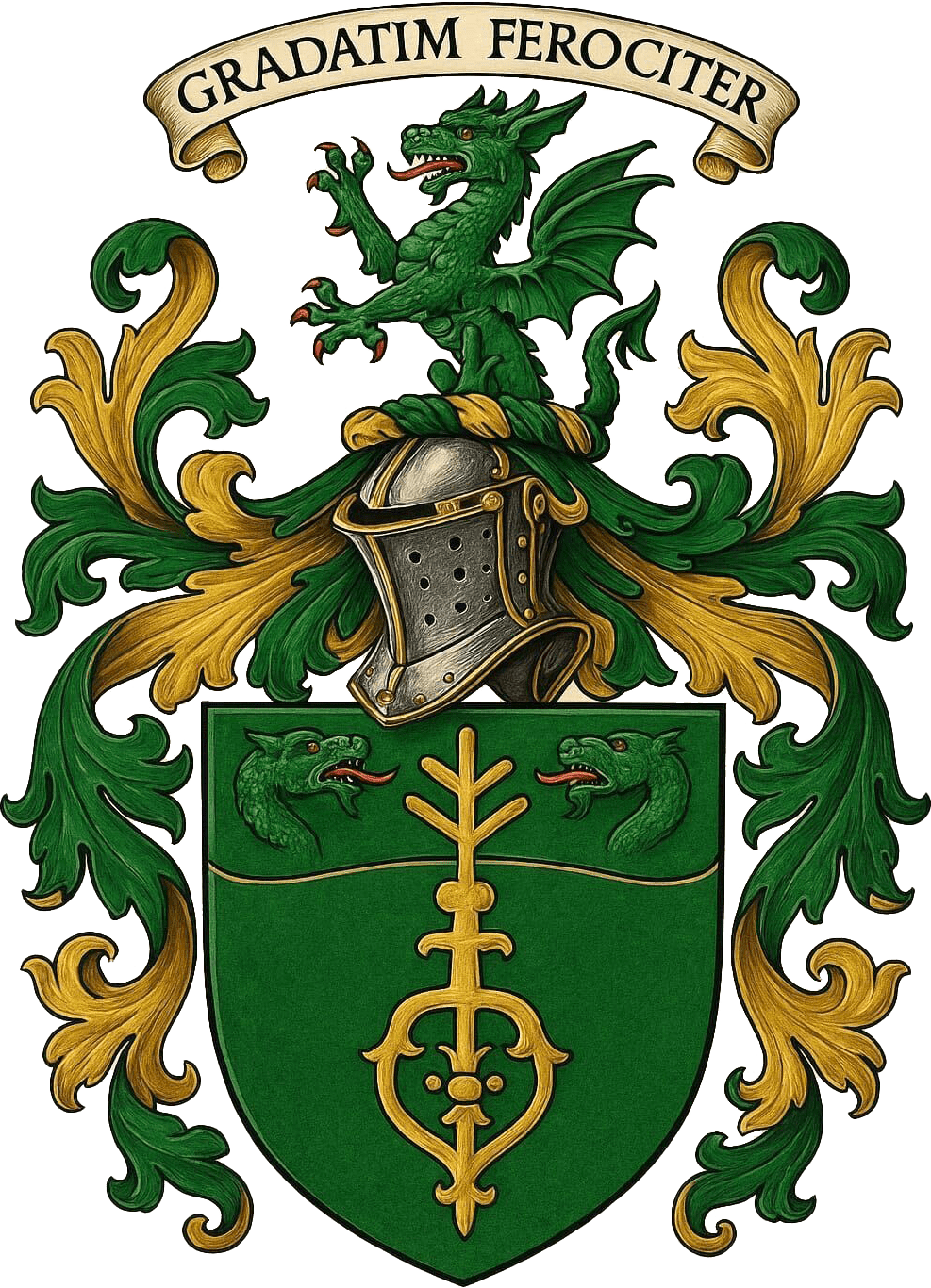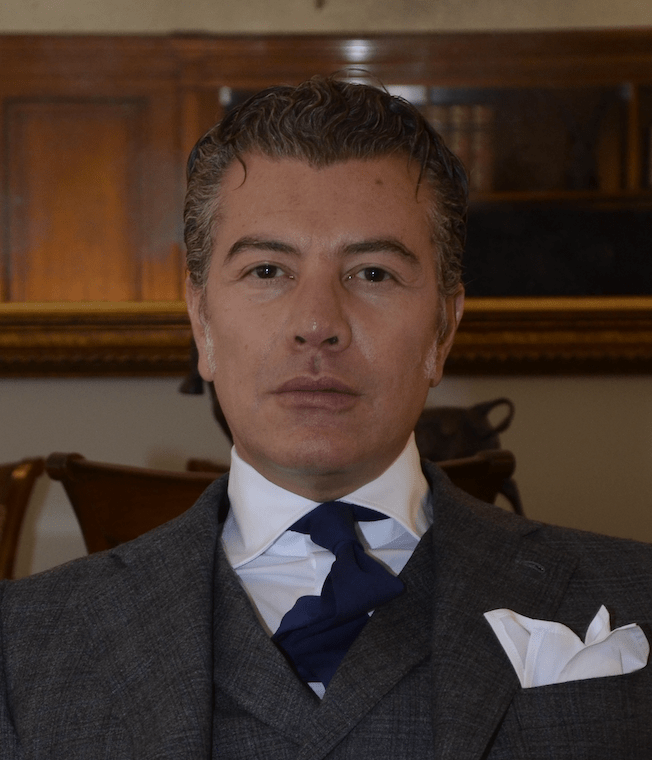"Step by step with determination"
Earl in the Baronage of Scotland
4th Class Non-Pledged (1st generation acquired title)
temporary office title can be transferred
THE EARL (LORD and BARON) OF ROTHES and hereditary Sheriff of Fife (Dario Item) [Much Hon The Earl of Rothes, Madrid, Spain] addressed as LORD ROTHES or MY LORD also 7th generation Prince of St Rosalie and Duke of Miraglia (Kingdom of Two Sicilies) known as professionally His Excellency Ambassador Dario Item, Earl of Rothes.
BORN in Napoli, Italy 28 Jun 1972, EDUCATED at University of Geneva/University of Teramo (Dr iuris 1996), University of Teramo (Dr rerum politicarum 2004), University of Genoa (Master’s 2005), University of Ferrara (Master’s 2006), University of Parma (PhD 2009), University of Teramo (LLM 2012).
Spouse
Andrea Dietschi Item The Countess of Rothes or Lady Rothes married 16 December 2000, and had four children.
Heir
Giulio Vittorio Item The Younger of Rothes born at Lugano, Switzerland 27 January 2013.
"Step by step with determination"
Earl in the Baronage of Scotland
4th Class Non-Pledged (1st generation acquired title)
temporary office title can be transferred
Achievements
Ambassador Extraordinary and Plenipotentiary of Antigua and Barbuda to the Kingdom of Spain, the Principality of Monaco and the Principality of Liechtenstein 2018-present, Permanent Representative of Antigua and Barbuda to the United Nations World Tourism Organisation (UNWTO) 2021-present.
- Medal of the Real Cuerpo de la Nobleza del Principado de Asturias, 14 November 2023
- Grand Collar of the Royal Order of the Eagle of Georgia, 7 November 2023
- Grand Collar of the Order of Merit of the Portuguese Royal House, 2 January 2022
- Knight Grand Cross of the Imperial Order of Emperor Menelik II, 16 April 2020
- Caballero of the Órden del Tercio de Extranjeros, 26 February 2020
- Caballero of the Maestranza de Caballería de Castilla, 1 April 2020
- Great Star of the Royal Order of the Crown of Georgia, 1 July 2020
- Senator Grand Badge of the Royal Order of Saint Queen Tamar, 1 July 2020
- Medal of the 1300° A. Proclamación del Rey Don Pelayo, 1 July 2020
- Medal of the Cruz de Distinción del Ejército de Asturias, 22 June 2020
- Medal of the Regimiento de Infantería Asturias n. 31, 24 June 2020
- Knight Grand Cross of the Royal Equestrian and Military Order of Saint Michael of the Wing, 27 September 2020
- Knight Grand Cross of the Royal Military Order of Our Lady of the Conception of Vila Viçosa, 8 December 2019
Lineage of Item
The lineage of the Prince of St Rosalie and Duke of Miraglia traces a distinguished seven-generation descent through the Item family, rooted in the nobility of the Kingdom of the Two Sicilies. Below is the genealogical succession, culminating in the present holder; Dario Item, Earl of Rothes, Hereditary Sheriff of Fife, Prince of St Rosalie, and Duke of Miraglia.
The lineage of the Prince of St Rosalie and Duke of Miraglia starts with:
- Josef Anton Item, married Hanna Elena Holzer (died 1830), and died 1820, from whom
- Jakob Item, born 15 April 1803, married 9 June 1838 Rachele Visconti (born 10 April 1805; died 11 January 1878), and died at Gaeta, Two Sicilies 3 June 1844, from whom
- Vincenzo Carlo Item, born 28 February 1839, married 9 October 1862 Chiara di Martino (born 24 April 1844; died 8 November 1912), and died 13 September 1900, from whom
- Aurelio Item, born 8 February 1871, married 29 October 1899 Giulia Pagano (born 9 May 1879; died August 1951), daughter of Domenico Pagano, and died 26 January 1941, from whom
- Ettore Item, born 14 May 1909, married 27 February 1929 Emilia Palumbo (born 15 August 1912; died 4 February 1999), and died 18 August 1988, from whom
- Giulio Vincenzo Vittorio Item, born 29 March 1931, married at Naples, Italy 13 December 1953 Liliana Galiani (born 17 July 1931), and died at Lugano, Switzerland 12 May 2006, from whom
- PRESENT EARL, see above
Earldom, Lordship and Barony of Rothes (1886)
The Earldom of Rothes is one of the most historically layered titles in Scottish history, bearing both peerage and baronial significance. Originally conferred in 1458 by King James II upon George Leslie, the creation of the Earldom coincided with the Crown’s grant of the territorial Barony of Ballinbreich. At this early stage, the title functioned within the framework of feudal nobility, whereby the dignity was inherently linked to territorial jurisdiction and ownership.
While the peerage dignity was unquestionably recognised by Parliament, the first recorded Crown Charter for the Earldom’s baronial (feudal) structure appears somewhat later, in a 1547 entry in the Register of the Great Seal of Scotland. This entry documents the consolidation of lands, markets, offices and dignities into what was styled the “whole and free Lordship and Earldom, Barony, Burgh of Barony and Lordship of Leslie and Earldom of Rothes” — a clear indication that the Earldom carried with it significant territorial dignity within the baronage of Scotland.
The dual character of the title becomes especially important in the 19th century. Upon the death of George William Evelyn Leslie, 13th Earl of Rothes, in 1859, the peerage title passed to his sister Henrietta Anderson Morshead Leslie, who became the 14th Countess of Rothes in her own right. That same year, Queen Victoria issued a Crown Charter of Confirmation dated 19 October 1859, affirming Henrietta’s right to the baronial lands, fairs, tolls, and offices including the Sheriffdom of Fife — all encompassed within the feudal Earldom.
Upon the Countess’s death in 1886, however, a pivotal divergence occurred: the peerage Earldom passed by standard primogeniture to an aunt, as per the rules of peerage inheritance, while the feudal Earldom — then still tied to land ownership — had earlier been conveyed into trust and later passed through conveyancing. In 1919, Captain William Crundall acquired the baronial title along with the feudal estate, separating it definitively from the peerage line.
This separation was possible due to reforms in Scots law, particularly the Conveyancing (Scotland) Act 1874, which facilitated the independent transfer of feudal dignities by allowing superiority and land to be separated in law and treated more flexibly in conveyancing. This effectively duplicated many such titles — resulting in some noble dignities persisting in parallel: one as a peerage dignity, the other as a baronial dignity associated with land.
By 2004, the legal framework changed again: the Abolition of Feudal Tenure etc. (Scotland) Act 2000, which came into force in November 2004, ended the feudal land system. Titles of barony and dignity were no longer real rights attached to land (heritable), but instead became incorporeal hereditaments — personal titles that could be assigned or inherited without land.
Today, the baronial Earl of Rothes remains a recognised title within the Baronage of Scotland, distinct from the peerage earl, both deriving from a common origin but representing separate legal identities. The baronial Earldom retains the cultural and territorial legacy of the original 15th-century creation and continues as a personal dignity, separate from the peerage system.
The late Sir Christopher Ondaatje, a noted explorer and philanthropist, was formally recognised by the Lord Lyon King of Arms as earl in the Scottish baronial tradition. This recognition affirmed the dignity’s continuity under heraldic law, even post-feudalism.
As of 2024 - Dario Item, Earl of Rothes succeeded to the baronial Earldom and Sheriffdom of Fife — titles which survive as historically-rooted, dignified styles within the Baronage of Scotland.
Hereditary Sheriffdom of Fife
The Sheriffdom of Fife is one of the oldest offices within the Scottish baronial tradition, dating to the 12th century under King David I. Sheriffdoms served as royal outposts of justice and governance, and Fife’s strategic importance made its sheriffdom particularly powerful.
By the 14th century, the office had become hereditary, often held by major landowning families such as the MacDuffs, Wemyss, and later the Leslies, Earls of Rothes. Hereditary sheriffs exercised real authority—overseeing local courts, collecting revenues, and commanding levies—often delegating duties to sheriff-deputes in Cupar and other towns.
The Heritable Jurisdictions Act of 1746, passed after the Jacobite uprising, abolished hereditary judicial powers and centralised authority under Crown-appointed sheriffs. The office became ceremonial but remained attached to noble estates, including the Rothes lands.
Today, while no legal powers remain, the dignity survives as a hereditary honour. In the 20th century, it passed with the baronial Earldom of Rothes. In the 21st century, Sir Christopher Ondaatje was recognised by the Lord Lyon King of Arms as Earl of Rothes and Sheriff of Fife. In 2024, the title passed to his successor - Dario Item, Earl of Rothes - who continues to hold this historic dignity within the Baronage of Scotland.


